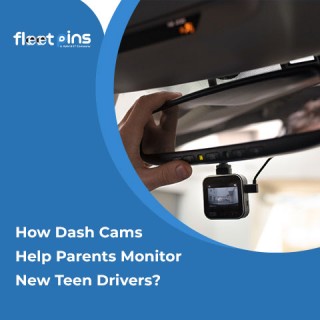- On 2025-03-13
How GPS Tracking Can Improve Driver Safety ?
Driver safety is a top priority for businesses that rely on transportation. It doesn’t matter what kind of fleet you have—delivery trucks, taxis, or NEMT vehicles—keeping drivers safe is the most important thing. GPS tracking is one of the best ways to improve driver safety. GPS tracking does more than just show where a vehicle is.
It helps prevent accidents, improves driving habits, and ensures quick help in emergencies. At Fleet Pins, we’ll explain how GPS tracking driving safety in different ways.
Monitoring and Reducing Risky Driving Behaviors
Many accidents happen because of unsafe driving, like speeding, sudden braking, and fast acceleration. GPS tracking helps managers watch these behaviors in real-time. They can give drivers feedback to help them drive more safely.
For even greater safety, consider pairing GPS tracking with Fleet Dash Cams, which reduce driver distractions and provide visual evidence of risky behaviors.
How GPS Tracking Improves Driver Safety
GPS tracking records data on speed, acceleration, and braking patterns. Fleet managers receive alerts when a driver engages in unsafe behaviors. Drivers can receive coaching and corrective feedback based on performance reports. GPS tracking reduces the risk of accidents caused by speeding and aggressive driving. It encourages responsible driving habits. It helps companies implement driver training programs based on real data.
Real-Time Location Tracking and Emergency Assistance
When an accident or emergency occurs, quick response time is essential. GPS tracking ensures that drivers are never alone. In an emergency, you can receive assistance promptly.
How GPS Tracking Helps in Emergencies
-
The system provides real-time location updates, making it easy to locate a driver in distress.
-
It can also automatically send alerts if a vehicle is involved in an accident.
-
Drivers can use an SOS button to request immediate assistance.
Fatigue Management and Route Optimization
Driver fatigue is a leading cause of accidents, especially in industries that require long hours on the road. GPS tracking helps reduce fatigue-related incidents by ensuring better route planning and rest breaks.
To further combat fatigue, AI Dash Cams can alert drowsy drivers in real-time, ensuring they stay alert and safe on the road.
-
GPS tracking monitors driving hours and alerts drivers when they need a break.
-
Intelligent route planning reduces unnecessary travel time, minimizing fatigue.
-
Managers can track driver workload and adjust schedules accordingly.
Theft Prevention and Vehicle Recovery
A stolen vehicle poses a significant safety risk to drivers, especially in high-crime areas. GPS tracking helps prevent theft and aids in vehicle recovery.
-
The system provides geofencing alerts if a vehicle leaves a designated area.
-
If a vehicle is stolen, GPS tracking allows law enforcement to recover it quickly.
-
Some systems enable remote vehicle immobilization to prevent unauthorized use.
Weather and Traffic Alerts
Unpredictable weather conditions and heavy traffic increase accident risks. GPS tracking systems provide real-time weather and traffic updates. It helps drivers navigate safely. GPS tracking integrates with weather forecasting services to provide alerts about hazardous conditions. Real-time traffic updates help drivers avoid congested or accident-prone routes.
Better Communication Between Drivers and Dispatchers
Effective communication is key to preventing misunderstandings and ensuring driver safety. GPS tracking enhances communication between drivers and dispatchers.
-
Two-way messaging systems allow dispatchers to provide real-time instructions.
-
Voice communication features enable hands-free calls to prevent distracted driving.
-
Route adjustments and delivery instructions can be sent instantly.
Compliance with Safety Regulations
Regulatory compliance is essential for maintaining a safe working environment for drivers. GPS tracking ensures that fleets adhere to safety and legal requirements.
For a comprehensive safety solution, explore Wired vs. Wireless Dash Cams to determine which system best meets your fleet’s compliance and operational needs.
-
GPS tracking records driving hours, ensuring compliance with HOS regulations.
-
Electronic logging devices (ELDs) automatically track driver activity to avoid violations.
-
Reports provide documentation for audits and inspections.
Encouraging a Safety-First Culture
A company’s safety culture plays a vital role in reducing accidents. GPS tracking integrates data-driven policies and promotes a proactive approach to driver safety. Tools like Driver Score can complement this by providing measurable insights into driver performance, helping managers identify areas for improvement and reward safe driving habits.
-
Driver performance reports encourage continuous improvement.
-
Drivers with excellent safety records can receive safety incentives.
-
Management can also identify high-risk drivers and provide additional training.
Conclusion
GPS tracking is more than just a map for Fleet management. It’s a safety tool that protects drivers, prevents accidents, and follows road rules. It helps by tracking driving habits. Allowing instant communication, planning better routes, and offering quick help in emergencies.
For businesses that depend on transportation, GPS tracking is a smart investment. It makes operations smoother and keeps drivers safe. Whether managing a fleet or a personal vehicle, GPS tracking improves road safety.
By fully using GPS tracking, companies can create a safer driving environment, reduce accidents, and improve transportation efficiency. Ready to see it in action? Book a Demo today and experience the benefits firsthand!




